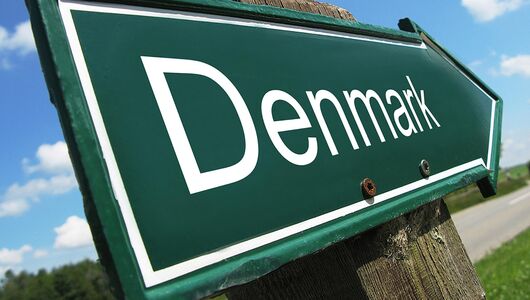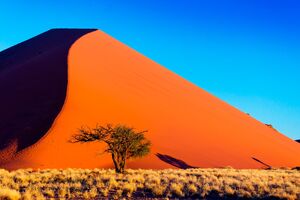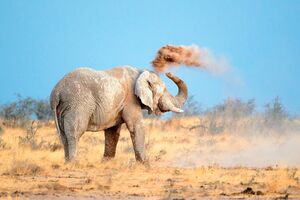Itinerary
Dag 1: Afrejse fra Danmark

Dag 2: Ankomst til Windhoek i Namibia og videre til Namib-ørkenen

Dag 3: Namib-ørkenen

Dag 4: Namib-ørkenen til Damaraland

Dag 5: Damaraland og Torra Reservatet

Dag 6: Damaraland til Ongava Reservatet ved Etosha

Dag 7: Ongava Reservatet

Dag 8: Ongava til Windhoek for hjemrejse

Dag 9: Hjemkomst til Danmark

Accommodation on the tour
Attractions on the tour

THE BIG FIVE
The Big Five is a historic term that comes from big game hunting. It groups together the five animals that were considered to require the most courage and skill to hunt: Elephant, rhino, buffalo, lion and leopard. The term has been readily adopted by today’s wildlife safaris, on which rifles have been swapped for a camera and animals are only “shot” through a telephoto lens. It is also widely used in the marketing of reserves, camps and lodges, where the “Big Five” can be found, and visitors have a reasonable chance of encountering them.
Read more
The Namib Desert
South western Namibia is totally dominated by the Namib Desert. The majority of the desert is under the protection of the Namib -Naukluft Park, which covers 6% of the whole country, some 50,000km2, which makes it the largest park in Africa and one of the very biggest national parks in the world. The most famous part of the park is the area close to Sesriem in its east, some 300km south of the capital Windhoek, and in particular Sossusvlei and Deadvlei, where there are a spectacular series of often dry flood plains.
Read more
North Western Namibia
Along Namibia’s Atlantic coastline, starting at the border with Angola and stretching 500km to the south, lies the Skeleton Coast Park, which was created to protect the coastline and a desert than runs around 40km inland. The park gets its name from the many whale skeletons, and the close to 1,000 shipwrecks that can be found on the beaches. There are also a number of river deltas along the coast, which have a fine avifauna and can also be visited by antelopes and predators. Along the coast you can also find a number of large colonies of fur seals, but the largest of which with its 100,000 inhabitants, lies just south of the park, around 150km north of Swakopmund, in a small reserve created for them at Cape Cross. The seals are always very active in these colonies, the large males often taking part in violent confrontations with each other, as they seek to defend their small territories. Occasionally the colonies receive unwelcome guests, brown hyena, jackals and even lions sometimes come down to the beaches to raid the populations of fur seals.
Read more
Etosha National Park
When it comes to big game then the 22,750km2 Etosha National Park is unquestionably Namibia’s finest, and it is possible to include this park amongst the most rewarding safari destinations in Africa. In the northwestern quarter of the park you can find the enormous salt flats that give the park its name. For much of the year this area is extremely dry, with white salts, left behind when the water evaporated, dusted over the soils. During the short rainy season between January and March, these flats are covered by shallow water, which gives new life to the local vegetation and attracts game animals and an incredible number of birds, with at times up to 1 million flamingos together with pelicans and smaller wading birds.
Read more

























